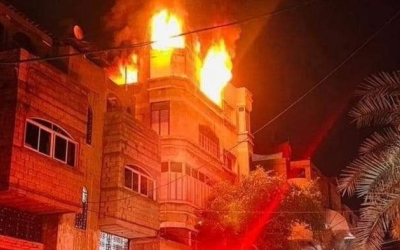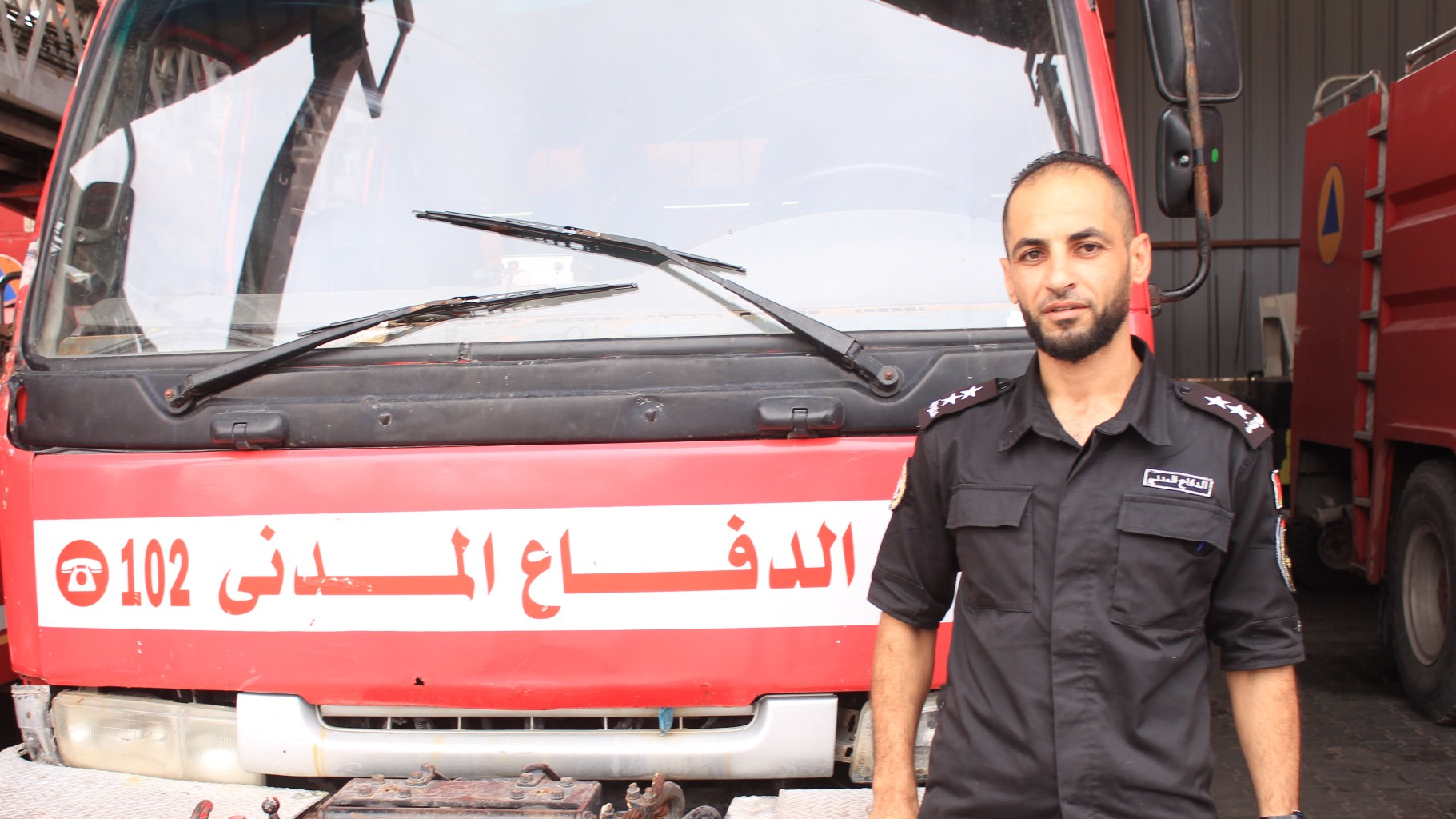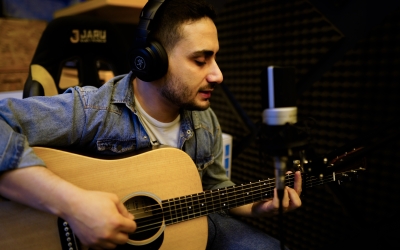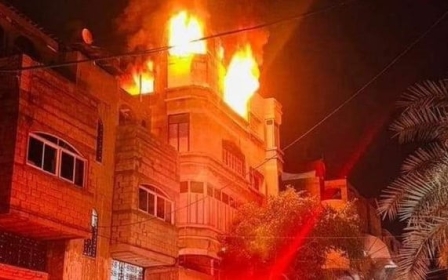Deadly fire to Israeli strikes: Gaza’s ill-equipped civil defence saves lives against the odds

Earlier this month, the Abu Raya family were gathering in the apartment where they lived in the besieged northern Gaza Strip to celebrate the return of a family member from abroad.
Suddenly, blood-curdling screams were heard coming from the residence, located in a building in the Tal Al-Zaatar neighbourhood of the Jabalia refugee camp.
The screams were from 22 people, all relatives gathered for the homecoming, who were trapped in the apartment on the top floor of the three-storey building as a huge fire broke out.
'The firefighting equipment was inadequate to control the massive fire'
- Mohammed al-Khaldi, eyewitness
As the alarm was raised, civil defence crews, furnished with outdated equipment, struggled to contain the fire.
“The firefighting equipment was inadequate to control the massive fire," Mohammed al-Khaldi, a witness to the blaze, told Middle East Eye.
New MEE newsletter: Jerusalem Dispatch
Sign up to get the latest insights and analysis on Israel-Palestine, alongside Turkey Unpacked and other MEE newsletters
He added that they pushed water from the fire engine to the third floor and struggled to go up the stairs to the apartment due to the fire, so they went up an adjoining house to try to put it out.
But the fire engine had run out of water after a short time, he said, and they had to take it to fill its tank from a nearby well, but the electricity was out, so they had to look for another source.
"[Although] many fire engines came quickly, it took them around an hour to distinguish the fire.”
Despite the crews trying their best to rescue those inside, all 22 people, including several children, were killed.
Recurrent incident
Since Hamas won legislative elections in 2006, Israel has imposed a land, air and sea blockade on Gaza, which has crippled almost all sectors in the coastal enclave, especially its civil defence abilities.
This month's fire was just the latest of several examples in recent years where those vulnerabilities have been exposed.
Mohamed al-Tahrawi was near his house in Al-Shout Camp in Rafah, in the southern Gaza strip, on 6 August when Israel targeted his neighbourhood with six missiles as part of its three-day offensive against the enclave.
Tahrawi rushed to his house but struggled to reach it due to the enormous amount of rubble left behind.
“The bombing was unbelievable, I've never seen such a thing before," he told MEE.
"Almost seven adjoining houses were flattened, and many people were killed and injured under the rubble. My sister Alaa was under three-storeys of rubble.”
The air strike killed eight Palestinians, including Khaled Mansour, commander of the southern division of the al-Quds Brigades, the military wing of the Palestinian Islamic Jihad movement (PIJ), two other PIJ fighters, three women and a child.
Civil defence crews equipped with iron chisels and shovels quickly arrived in Hummers, said Tahrawi, sitting where Alaa’s house had once been.
However, with so much rubble, they had to call for a bulldozer from Gaza City, which took almost two hours to arrive.
“The crews and neighbours were digging tirelessly with their moderate equipment and their hands until the bulldozer came at 12am," said Tahrawi.
"They pulled out the two bodies at 2.30am, then managed to find my sister’s body, which was scattered everywhere, at 5am.
“After the war, when removing the rubble, we found some of her parts, including her hand,” he added with a sad voice.
Israeli siege blamed
The spokesman of Gaza's civil defence authority, Major Mahmoud Basal, told MEE that they suffered greatly from a lack of equipment due to the Israeli blockade.
“We have 31 fire engines working since 1994. They barely work and should be renewed every five or six years," he said. "We don’t have any bulldozers, special cranes to pull out flattened roofs during the Israeli aggressions, or devices for detecting humans trapped under rubble.
"Israel also bans firefighting foams, anti-fire suits and shoes, oxygen-breathing apparatuses, and respirators. Our crews haven’t had any training abroad since 2006 due to the blockade."
The major noted that they have only one portable 15,000-litre tank to support their poor-condition fire engines, whose tanks range from 3,000 to 5,000 litres and run out of water in minutes.
He pointed out that Gaza has 2700 inhabitants per civil defence worker, although the standard is supposed to be one per 1000.
A rescue after 12 hours
During the 11-day Israeli assault on Gaza in 2021, Israel committed a massacre on Al-Wehda Street on 16 May, killing more than 40 civilians.
"When we arrived, more than 20 wounded and killed people were under al-Kulak’s family three-storey building. I was shocked as I didn’t know what we should have done with the rubble with hummers and shovels," said Mustafa Hamdan, a first lieutenant officer and a trainer in civil defence.
“I went down under the rubble and shouted: 'Is there anyone here?' Then a woman with a faint voice replied: 'Yes, I am here,'” he added.
That woman was Zainab al-Koluk, who was lucky as she was holding her phone when they were bombed. The crews were talking to her on the phone while digging to locate her place under rubble.
“There were many people under the rubble, so we had to lift the grounded roof by a bulldozer and turn it off to be able to hear the trapped, then to turn it on to dig again. We had been doing the same thing from 2am to 4:30am,” he added.
“Then we found her father, Shukri, buried until his head but alive. Suddenly, Zainab’s phone battery died. I lost my strength as I thought she had died. Imagine a person is trapped under three-story rubble and appealing to you to rescue him, but you don’t have the equipment to do so.”
After 12 hours, they managed to pull Zainab out, but she had fainted.
“Imagine, we put our heads under rubble in wars to figure out if someone is alive because we don’t have devices for detecting the trapped. But we have to do our jobs to rescue others,” the officer added.
Zainab lost 22 of her relatives that night, including her mother and three siblings.
Avoidable deaths
Khaled al-Malfouh was sitting with his family at midnight on 13 May 2021 in Al-Sheikh Zayed City in the north of Gaza.
“I heard a noise outside. Some of my neighbours were screaming as they had thought a nearby tower would be bombed. That was one minute before bombing us. We quickly gathered in the same room and started hearing the rockets pouring on our neighbourhood,” he said.
'If we had the necessary equipment, we would have rescued high numbers of casualties'
- Major Mahmoud Basal
“Suddenly, our house was targeted, and all of us dropped down under three stories of rubble. I was buried until my chest. I called all my family members to know if they were alive, thankfully all of them replied, except my mother, who had fainted.”
Luckily, a concrete column bore the roof and made a tent under which the family were.
The survivor, 27-year-old Khaled, was holding his phone in his hand after the bombing, so he called his friend, living next to him, to bring rescue workers.
“The crews arrived in minutes. I requested that they rescue my mother, who had fallen six metres under me and had her pelvis crushed by a wall," Khaled said.
“They kept working hard for thirty to forty minutes until they managed to pull out my mother. Then after almost an hour, they rescued all of us.”
All of his seven-member family, including three children, were injured; his mother and sister were both in serious condition. The air strikes killed nine people, many of whom were pulled out from the rubble after 17 hours.
“If we had the necessary equipment, we would have rescued high numbers of casualties, since it is normal for a trapped wounded person to die if he stays [bleeding] six hours under rubble," said Major Mahmoud Basal.
This article is available in French on Middle East Eye French edition.
Middle East Eye delivers independent and unrivalled coverage and analysis of the Middle East, North Africa and beyond. To learn more about republishing this content and the associated fees, please fill out this form. More about MEE can be found here.







